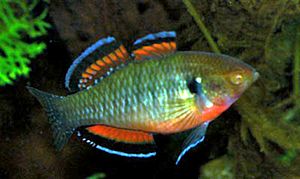Empire gudgeon facts for kids
Quick facts for kids Empire gudgeon |
|
|---|---|
 |
|
| Conservation status | |
| Scientific classification | |
| Synonyms | |
|
Eleotris compressus Krefft, 1864 |
Hypseleotris compressa, also known as the empire gudgeon, is a cool fish found only in Australia and south-central New Guinea. It's a type of Gobiiform fish that belongs to the family Eleotridae.
Contents
Discovering the Empire Gudgeon
A scientist named Gerard Krefft first described the empire gudgeon in 1864. He called it Eleotris compressus back then. A person named James F. Wilcox found this fish.
What Does the Empire Gudgeon Look Like?
The empire gudgeon has a long, thin body. It can grow up to 12 cm (4.7 in) long. Male fish are usually bigger than females. This fish does not have a lateral line, which is a special sensing organ. However, it does have ctenoid scales, which feel rough.
Colors and Patterns
The fish's color can change a lot. It often has a yellowish-tan or golden-brown head. Sometimes, its head can even be dark brown. Its belly is usually a whitish-red color.
When it's not breeding season, male fish have colorful bands. These bands are on their anal and dorsal fins. The tail fin is a bit dark, and the other fins have no color.
Bright Breeding Colors
During the breeding season, male empire gudgeons become very colorful. They turn a bright red-orange color. They sometimes even look like they are glowing! The male uses these bright colors to attract a mate. This fish can also change its colors quickly when it needs to.
Where Does the Empire Gudgeon Live?
Most empire gudgeons live in northern and eastern Australia. They are also found in south-central New Guinea. You can find them in the Torres Strait too. This includes areas around Muralag and Horn Island.
Its Home Environment
This fish usually lives in freshwater rivers or streams that are flowing. But it can also live in still water. It can even handle water that is as salty as the sea! You will often find them in the lower parts of rivers. However, they can also live further upstream.
Empire gudgeons like to swim among water plants and branches. They sometimes hide among rocks, using them like small "caves."
What Does the Empire Gudgeon Eat?
The empire gudgeon is an omnivore. This means it eats both plants and animals. It mostly eats small crustaceans, which are like tiny crabs or shrimp. It also eats insects. Sometimes, it will eat algae and other water plants.
Reproduction and Life Cycle
Empire gudgeons usually lay their eggs in fresh water. This happens during warm weather, generally from spring to autumn. After the female mates with a male, she lays about 3,000 eggs. These eggs are very small, about 0.32 mm long. They have a sticky coating.
Egg Laying and Hatching
The eggs stick to different surfaces. These can be plants, logs, rocks, or even sand. The male then fertilizes the eggs. He guards the eggs until the young fish hatch. This usually takes about 10 to 14 hours.
After hatching, the tiny young fish swim downstream. They go to estuaries, which are places where rivers meet the sea. They grow and develop there. Once they are grown, the fish return to fresh water. It can be tricky to breed these fish for aquariums because of this life cycle.
Empire Gudgeon and Mosquito Control
Scientists did a study in Brisbane, Australia. They compared six native fish species with an introduced fish called the eastern mosquitofish. They wanted to see which fish was best at eating mosquito larvae. Mosquito larvae are baby mosquitoes.
The study found that the empire gudgeon was just as good at eating mosquito larvae as the eastern mosquitofish. This means the empire gudgeon could be a good helper in controlling mosquitoes.


